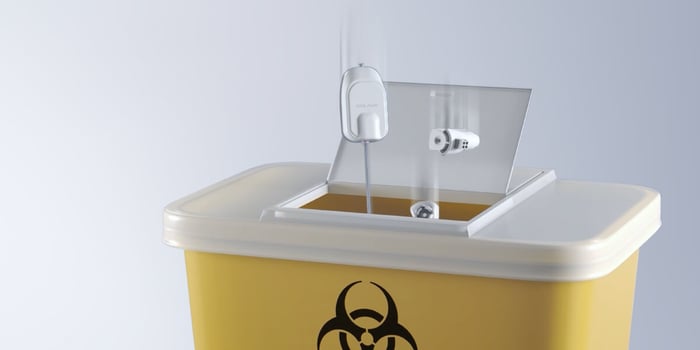Transitioning to a single-use mindset, getting ahead of the curve
If single use devices are inevitable, the next step after “why” needs to be an understanding of “how” medtech companies and device makers can get on the right side of the movement.

The move towards single use scopes and other medical devices had its start long before Covid-19, but the pandemic has accelerated this trend across the medical technology field. An emphasis from providers and payers on infection prevention, improved workflow and better health economics points towards disposable as the default.
While this may be a given for newly launched devices and companies, a turn towards single use is problematic for more deeply entrenched companies and vendors that have designed for reusability. Leaders evaluating the case for disposability should keep three areas of emphasis in mind as they enact strategies to ease their own transition towards single use.
The move to single use
Between July 2015 and January 2021, the FDA received over 860 reports of infections related to reusable flexible bronchoscopes alone1. The need for infection prevention grew more urgent during the pandemic, with the four “p’s” – patients, practitioners, providers and payers – all prioritizing it across procedures, devices and settings.
This emphasis and reports like the one it received on bronchoscopes and the incidents in the gastroenterology cases are likely primary drivers that led the FDA to recently update its recommendations for duodenoscopes, endorsing the use of single use or disposable scopes over reusable devices.
There is also an economic case for single use devices. Counter to what some may naturally assume, reusable devices take a much bigger chunk out of a provider’s budget than disposable ones. This was proven in a granular study by PharmacoEconomics2 that examined the time and cost of materials, man hours, and the occurrence of infections for reusable devices. Single use scopes allow hospital administrators and CFOs to revisit all hidden costs and save for the hospitals and patients.
Finally, single use devices can aid workflow efficiency. Clinicians and staff always have a device ready when needed and time is saved post-procedure by simply discarding a tool rather than having to clean and store it properly. Performing a procedure anytime, anywhere, becomes possible with single use endoscopes. Disposable implements also never need repair or reprocessing, saving significant time and money while preventing workflow interruptions caused by potential delays.
So, if single use is inevitable, the next step after “why” needs to be an understanding of “how” medtech companies and device makers can get on the right side of the movement. Those organizations and leaders embracing this move would do well to keep three things in mind to ensure a successful transition to single-use devices.
Clinical value always wins
Why: New device introduction provides an opening to showcase new technologies and applications for a medical setting. But technology for technology’s sake often struggles to deliver lasting value. Single-use products avoid this trap by providing a unique clinical value to patients and caregivers in the form of reduced risk and more efficient processes.
How: Communicating this value as part of your commercialization efforts is paramount in ensuring the message resonates with clinicians, hospitals and health systems. Many innovators often ignore this step and assume the value proposition is obvious or that the data will speak for itself. Instead, lead in marketing and sales with a clear message and strong expectations for the proven value of single-use devices over time.
Design for efficiency and workflow
Why: It is imperative to design new single-use devices with clinicians and workflow in mind. The goal of disposable devices is to improve on efficiency and reduce contamination versus reusable devices, making work easier for providers and outcomes better for patients. Medtech companies should spend the time on the front end to thoroughly understand current clinical workflow in order to design for maximum efficiency when using disposable devices.
How: This is easier said than done as designing a new product requires a deep understanding of the current technological landscape, customer perceptions, and internal company economics and capabilities. Focus groups, broad market research, clinician shadowing, and other front-line views into daily workflows can help fill in the gaps. Having these important perspectives will make it easier to clear the very high hurdle for commercializing a single-use solution and deliver on the promise of short and long term benefits.
Shine a light on hidden costs
Why: One of the main drivers toward single-use products in the U.S. healthcare system is cost and efficiency. Although direct purchase costs may be comparable or even slightly more expensive, single-use products provide both tangible and hidden economic benefits over time such as more efficient room turnover, reduced burden on hospital cleaning staff, and reduced risk of cross contamination and readmission of patients.
How: Device companies are well attuned to building out unit economics as part of their commercialization efforts, but disposable devices often require a more nuanced examination. Providers must do the hard work up-front to uncover hidden costs such as infection risks and the time and expense of cleaning reusable devices in order to make a more comprehensive pitch for long term economic savings by health systems and payers. Some of this may be anecdotal as evidence is still being generated, but it aligns with a growing global consensus regarding the economic advantage of single-use products.
In summary, the gradual shift to single-use products has continued to change the way companies, investors, and medtech leaders think about the healthcare space. There are clear advantages to developing single use products, but every solution is different and the gaps need to be uncovered, defined and then filled in order to justify the development cost. By focusing on customer efficiencies, cost reduction and most importantly, better patient outcomes as universal benefits, companies can maintain focus and momentum in this important shift towards the future of medical devices.
2
